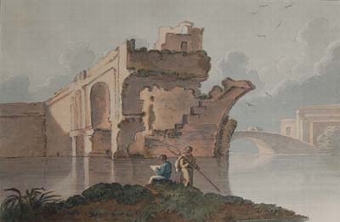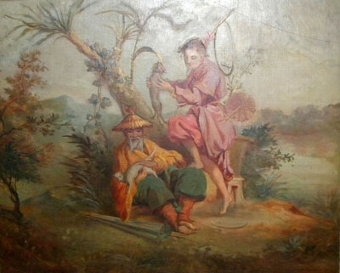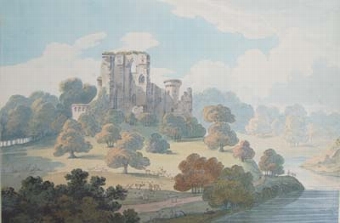featured item
the falls at tivoli, lazio, italy
- View other items in:
- antiques interior design modern and vintage
- other interior design
artware ltd
Enquire about this antique
Artware Ltd has 565 antiques for sale.
click here to see them all
Tivoli, the classical Tibur, is an ancient Italian town in Lazio, about 30 km from Rome, at the falls of the Aniene river, where it issues from the Sabine hills. There are spectacular views out over the Roman Campagna. Gaius Julius Solinus cites Cato the Elder''s lost Origines for the story that the city was founded by Catillus the Arcadian, a son of Amphiaraus, who came there having escaped the slaughter at Thebes, Greece. Catillus and his three sons Tiburtus, Coras, and Catillus drove out the Siculi from the Aniene plateau and founded a city they named Tibur in honor of Tiburtus. According to a more historical account, Tibur was instead a colony of Alba Longa. Historical traces of settlement in the area date back to the 13th century BC.
Virgil in his Aeneid makes Coras and the younger Catillus twin brothers and the leaders of military forces from Tibur aiding Turnus. From Etruscan times Tibur, a Sabine city, was the seat of the Tiburtine Sibyl. There are two small temples above the falls, the rotunda traditionally associated with Vesta and the rectangular one with the Sibyl of Tibur, whom Varro calls ''Albunea'', the water nymph who was worshipped on the banks of the Anio as a tenth Sibyl added to the nine mentioned by the Greek writers. In the nearby woods, Faunus had a sacred grove. During the Roman age Tibur maintained a certain importance, being on the way (the Via Tiburtina, extended as the Via Valeria) that Romans had to follow to cross the mountain regions of the Apennines towards the Abruzzo, the region where lived some of its fiercest enemies such as Volsci, Sabini and Samnites. At first an independent ally of Rome, Tibur allied itself with the Gauls in 361 BC. Vestiges remain of its defensive walls of this period, in opus quadrata. In 338 BC, however, Tibur was defeated and absorbed by the Romans. The city acquired Roman citizenship in 90 BC and became a resort area famed for its beauty and its good water, and was enriched by many Roman villas. The most famous one, of which the ruins remain, is the Villa Adriana (Hadrian''s Villa). Maecenas and Augustus also had villas at Tibur, and the poet Horace had a modest villa: he and Catullus and Statius all mention Tibur in their poems. In 273, Zenobia, the captive queen of Palmyra, was assigned a residence here by the Emperor Aurelian. The 2nd-century temples of Hercules Victor is being excavated. The present Diazza del Duomo occupies the Roman forum. In 547, in the course of the Gothic War, the city was fortified by the Byzantine general Belisarius, but was later destroyed by Totila''s army. After the end of the war it became a Byzantine duchy, later absorbed into the Patrimony of St. Peter. After Italy was conquered by Charlemagne Tivoli was under the authority of a count, representing the emperor. From the 10th century onwards Tivoli, as an independent commune governed by its elected consuls, was the fiercest rival of Rome in the struggle for the control over the impoverished central Lazio. Emperor Otto III conquered it in 1001, and Tivoli fell under the Papal control. Tivoli however managed to keep a level of independence until the 15th century: symbols of the city''s strength were the Palace of Arengo, the Torre del Comune and the church of St. Michael, all built in this period, as well as the new line of walls (authorized in 1155), needed to house the increasing population. Reminders of the internal turbulence of communal life are the tower houses that may be seen in Vicolo dei Ferri, Via Postera, Via del Seminario and Via del Colle.
In the 13th century the Senate of Rome imposed a tribute on the city, and gave itself the right to appoint a count to govern it in conjunction with the local consuls. In the 14th century Tivoli sided with the Guelphs and strongly supported Urban VI against Antipope Clement VII. King Ladislaus of Sicily was twice repulsed from the city, as well as the famous condottiero Braccio da Montone. During the Renaissance popes and cardinals did not limit their embellishment program to Rome, and erected buildings in Tivoli also. In 1461 Pope Pius II built the massive Rocca Pia to control the always riotous population, and as a symbol of the permanence of papal temporal power here. From the 16th century the city saw further villa construction. The most famous of these is the Villa d''Este, begun in 1549 by Pirro Ligorio for Cardinal Ippolito II d''Este and richly decorated with an ambitious program of frescoes by famous painters of the late Roman Mannerism, such Livio Agresti (a member of the "Forl? painting school") or the Zuccari brothers. In 1527 Tivoli was sacked by bands of the supporters of the emperor and the Colonna, important archives being destroyed during the attack. In 1547 it was again occupied, by the Duke of Alba in a war against Paul IV, and in 1744 by the Austrians.In 1835 Pope Gregory XVI added the Villa Gregoriana, a villa complex pivoting around the Aniene''s falls. These were created through a tunnel in the Monte Catillo, to give an outlet to the waters of the Aniene sufficient to preserve the city from inundations like the devastating one of 1826. In 1944 Tivoli suffered heavy damage under an Allied bombing, which totally destroyed the Jesuit Church of Jesus. Tivoli''s reputation as a stylish resort and the fame of the gardens of the Villa d''Este have inspired other sites named Tivoli.
Antiques.co.uk Ref: VMRVBVXJ
- Materials:
- Watercolour
- Width (cm):
- 22.86 x 15.24 cm 9.00 x 6.00 ins
Artware Ltd
Artware Fine Art specialises in fine antique, decorative and historical portraits and topographical pictures . We cover a period from the 17th and 18th centuries through to the 19th & 20th Centuries. We have over 150 portraits in stock, which can be viewed on our web site, each historical portrait has well researched biographical information both on the sitter and the artist.
Contact details
18 La gare
51 Surrey row
London
Greater London
SE1 0BZ
UNITED KINGDOM
T: 0207 921 97904
E: greg@artwarefineart.com
W: www.artwarefineart.com














